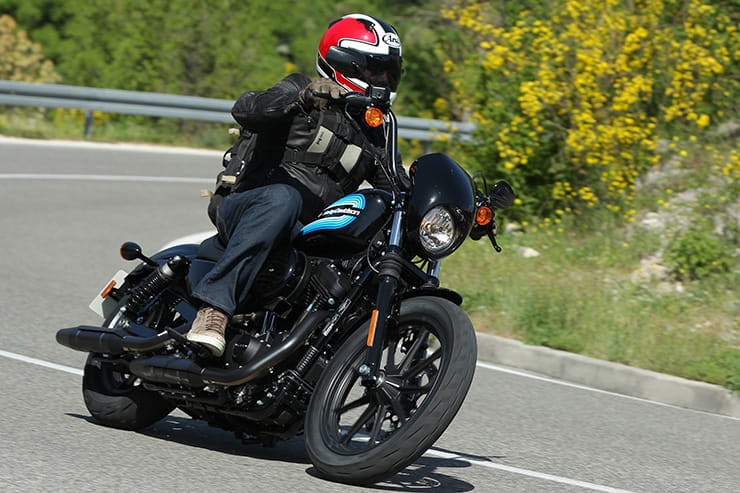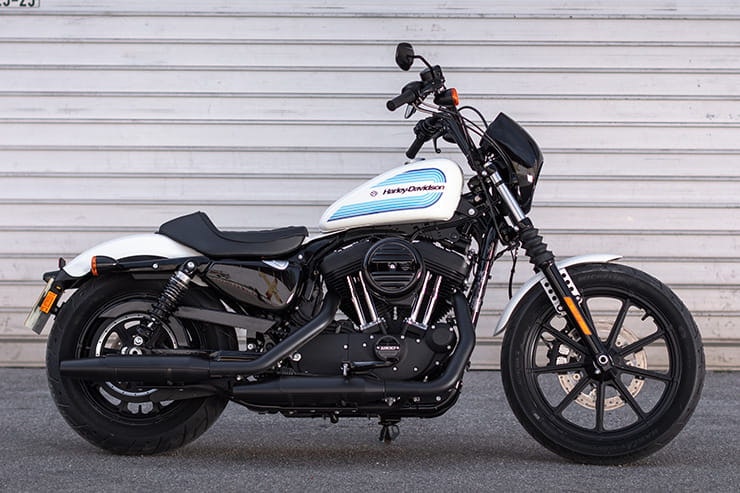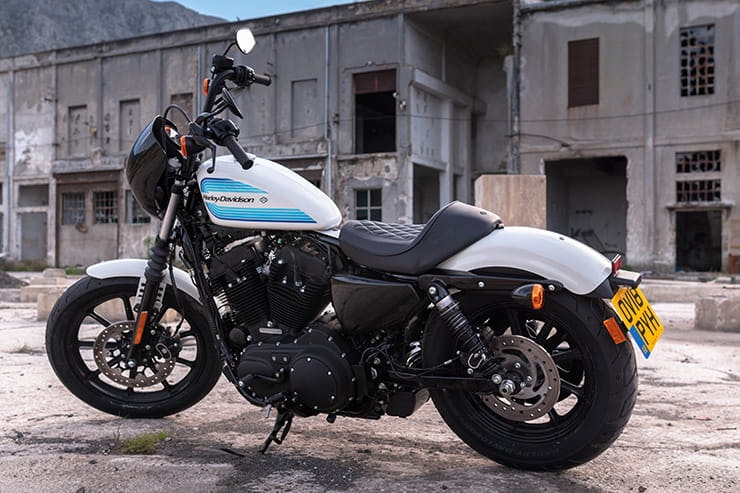Harley-Davidson Iron 1200 and Forty Eight Special (2018) | Review
By John Milbank
Consumer Editor of Bennetts BikeSocial
01.05.2018
Kit Credits
Helmet
Arai Renegade V Outline: £52.99 | www.whyarai.co.uk
Jacket
Harley-Davidson 115th Anniversary : £491.08 | www.harley-davidson.com/gb
Trousers
Hood K7 Infinity: £152.99 | www.hoodjeans.co.uk
Boots
TCK Drifter WP: £259.99 | www.nevis.uk.com
Gloves
Furygan James: £84.99 | www.nevis.uk.com
The 2018 Harley-Davidson Iron 1200 has mid-mounted pegs and a headlight cowl, among many other differences to the new Forty Eight Special
It never ceases to amaze me how closed-minded some people can be. Post anything relating to Harley-Davidson on social media and you’ll be faced with a barrage of derogatory comments; “Hardly Movingson”, “They all look the same”, “They don’t go around corners…” I could go on. I guess the haters are indeed going to hate.
It’s ironic that a brand that can provoke so much venom from some circles, can provide so much enjoyment to so many others. Whether it’s the social scene of Harley ownership (which is not a requirement, merely one of many sides to it), or the sheer pleasure of riding something simple; riding something purely for the love of the ride itself.
Harley-Davidson has launched two new models – the Iron 1200 and the Forty Eight Special. They share the same frame and engine, but they’re quite different to ride. I’m not going to try to argue that they don’t look pretty similar to the untrained eye, but they’re both Sportsters. Let me stop you there; I didn’t say sportsbikes. I said Sportsters, which is a range of Harleys that look quite different to the Tourers or the Softails or the smaller Streets. Okay, they all have a very similar style, but what do you expect of a machine powered by such an iconic V-twin motor. It’s all about the engine, and that goes a long way to setting the look.
The 2018 Harley-Davidson Forty Eight Special has a distinctive ‘peanut’ tank, fat front tyre and great AMF-style graphics
What’s the difference?
The point of having several similar-looking-at-first-glance bikes in its range is that H-D is trying to offer something for every rider. Here are the key differences between the two new machines…
There are other changes, like the seat shape, the wider-spaced yokes of the Forty Eight, the wheel design, the finishes on the engine and of course the cowl (and gaiter) on the Iron. All of these are option parts that you could use to modify your Harley to suit you, but the point is that you can buy the machine that fits you best, and looks as close as possible to how you want it. Just be prepared to want to tweak it once you’re bought in – Harley-Davidson dealerships are very welcoming places, and it’s easy to suddenly feel the need to ‘just make one more change’…
The key thing is that, despite these machines sharing an engine and frame (what other manufacturer doesn’t do this?), they’re very different to ride.
They’re both single-seat machines, but the seats are quite different in feel and design. The Iron has the quilted seat
Price
The new Iron 1200 is £9,395 in black, or £9,646 in colour. The smaller-capacity Iron 883, which has long been a popular entry point for many Harley owners, has crept up in price to £8,895.
The Forty Eight Special costs £9,995 in black or £10,245 in colour, and is differentiated from the ‘standard’ Forty Eight (which is the same price) by its distinctive 1970s AMF-inspired paint scheme, black cylinder heads, chrome crank cases, a ribbed seat covering and 7.25”-high ‘Tallboy’ handlebars.
American Machine and Foundry (AMF), owned Harley between 1969 and 1981.
The engine is a key design point of any Harley
Power and torque
You don’t buy a Harley if all you care about is the spec sheet. If you believe you need 200bhp to enjoy a road ride, then I’ll stop trying to convince you that you’re daft to completely dismiss the American brand.
Both the Iron 1200 and the Forty Eight Special make 65.7bhp (49kW) at 6,000rpm and 70.1lb-ft (96Nm) at 3,500rpm. To give a little perspective, a Yamaha MT-09 makes 113.5bhp at 10,000rpm, but 64.5lb-ft at 8,500rpm. Harleys have always been torquey beasts, and they wield that punch very low down in the rev range, so stop whittling on about the performance figures and experience it.
Engine, gearbox and exhaust
The 1202cc air-cooled V-twin engine is shared between the bikes. It’s the same one as in the original Forty Eight, and it makes 36% more torque than the Iron 883’s motor. It’s great to still see a manufacturer capable of putting out traditional air-cooled engines when Euro 4 emissions regulations have seen the end of so many others.
The exhaust isn’t going to upset your neighbours (though there are hundreds of after-market options), but there’s still the distinctive throb from this massive powertrain; you certainly won’t be disappointed if you decide to stick with the standard pipes. That pulsing does translate into a degree of vibration through the pegs when revving high, but I didn’t find it annoying. Saying it adds character is something too easily pinned on a bike, but it really does apply here.
Gear changes are typical Harley – you won’t find any fancy quick-shifters, and clutchless shifts are hard to do smoothly. Pull in the heavy, non-span-adjustable cable-operated clutch, put some weight on the lever, and the ’box will clunk satisfyingly into place. It’s not about fast changes for optimum lap times, it’s about a more leisurely pace of ride. Still reading? Good; perhaps you’re the kind of rider that understands the pleasure that can be had by kicking back and taking it easy sometimes.
Of course, some riders are too fast for a Harley-Davidson; they absolutely need all the performance offered by today’s hyperbikes on the road. But others seem happy to go a little slower sometimes, like Harley-owning six-time British Superbike Champion Shakey Byrne. Or Formula One World Champion Jenson Button.
The tiny peanut tank (shown here in black) is a favourite of many Harley-Davidson fans, but don’t expect huge range from it. The Iron 1200 (here in white) has the greater capacity
Economy
There’s no fuel economy read-out on the Iron or Forty Eight dash, so as we’re not in control of the fuel stops on a launch, it’s not possible to give a tested economy figure. Harley claims 54mpg for the 1200 Evolution engine, which given the 12.5 litre tank of the Iron 1200 would promise a range to dry of 149 miles.
The Forty Eight’s 7.9 litre tank would be onto vapour after 94miles given these figures, though I know of one Harley owner who’s had 100 miles while riding their Forty Eight – they had to ride very carefully to get that, but told me that 80 miles between filling stations is easy.
Tourers these are not, and you’d buy a Forty Eight because of that tiny ‘peanut’ tank’s silhouette, not because you want to commute 100 miles every day.
The rear shocks are adjustable for preload only. The Forty Eight has the fatter forks of the two machines
Handling, suspension, chassis and weight
Besides preload on the pair of rear shocks, neither bike has any adjustment. Despite the Forty Eight carrying thicker forks than the Iron 1200 – set in wider yokes – there’s no obvious difference in the feel of the setups. Given that the machines weigh 256kg ready to ride, it shouldn’t be too surprising that neither has particularly forgiving suspension; a combination of weight management, low ride height and relatively short travel means bumps in the road can feel somewhat harsh.
Push hard and you’ll soon find the limits of ground clearance with both these bikes. The Iron will scrape at 28° on the left and 27° on the right (where the exhaust is fitted on both). The Forty Eight, with its forward-mounted pegs, offers 27.1° on either side. Both have hero blobs to warn you if you’re getting a little enthusiastic, but both will also very quickly touch down the bottom of the exhaust. If those scrapes – which you have to get on your hands and knees to see – are likely to bother you, you’ll just need to shift your body weight off to the inside of the corners a little to prevent it.
The brakes are okay for a machine of this speed
Brakes
A single two-piston caliper on the front of each bike is never going to offer two-finger braking, but the ABS-equipped systems are combined, so the rear operates the front, and vice-versa. It works fine for the speeds you’ll likely be riding, even considering these motorcycles are the weight of a well-loaded adventure bike.
Comfort
With its mid-mounted pegs, you’d expect the Iron 883 to be the more comfortable of the two, and in some ways it is – you’re able to take the weight off your bum by pushing yourself up off your legs, but while it’s not possible with the Forty Eight’s forward controls, I found that machine a little more easy-going. To be honest, it’s probably as much to do with the shape of the seat as it is the shape of my behind, and realistically, you’re not going to smash out hundreds of miles on either motorcycle without a break. Once again though… That. Is. Not. What. These. Bikes. Are. About.
The Forty Eight’s smaller tank might be an advantage if anything, as it encourages more frequent breaks for a stretch, a coffee, and reflection on how damned lucky you are to be a biker.
The Iron 1200 gets a front cowl, while the Forty Eight Special keeps things more simple
Equipment
Have you noticed how many people moan about all the electronics on bikes these days? Yet many of the same bunch hate Harleys.
It’s hard to think of a more pure and unadulterated premium modern motorcycle than a Harley-Davidson; ABS is a legal requirement, but you won’t have to faff about with riding modes, traction control or any of that nonsense here. Fuel injection, yes, but it’s totally unobtrusive. A Harley is all about the ride, and there are no computers to dull that experience.
The single, elegant analogue speedo has a small LCD panel in the bottom that can display time, gear and revs, two trips and an odometer. You can flick through those using a button on the left bar.
Riding the Forty Eight Special (here in white) and Iron 1200 (in black) back to back highlights surprising differences in feel
Back to back on the Iron 1200 and Forty Eight Special
Surprisingly, swapping between the Iron 883 and the Forty Eight Special shows what different bikes these are; where the Iron has an upright, almost new-rider feel to it from my point of view, the Forty Eight feels much more ‘Easy Rider’.
One shorter journalist at the launch said he felt more comfortable on the Iron, another said it was more confidence-inspiring. Yet I felt more able to hammer the corners on the Forty Eight. Which is nonsense, as the specs say they’re practically the same.
Equally, while the front wheel sizes are different, and the tyre much fatter on the Forty Eight, both felt very similar in handling – if anything, I thought the Forty Eight was slightly more nimble, but its bigger rubber should contradict that, on paper at least.
Ultimately, they feel like quite different machines to sit on, but it’s impossible to pigeon-hole them; the only way to know which feels right for you is to have a go. Just remember where to put your feet if you jump on the Forty Eight after the Iron, rather than wobbling off with your legs flailing in front of the UK media. Ahem.
2018 Harley-Davidson Iron 1200 and Forty Eight Special verdict
If you read this review purely for the facts and stats, you’re probably thinking ‘why the hell would I ride one of those’. But the fact that you’ve got this far makes me think you’re a little more open-minded than the keyboard warriors who plague social posts about these machines.
In many ways, owning a Harley makes little logical sense; these two aren’t that practical, they’re not very fast by modern every-day bike standards, and they’re not overly comfortable. But despite all that, they’re enormously pleasurable to ride. They’re the kind of bikes that you just can’t help but look back at as you walk away after parking up.
Personally, it’s the Forty Eight Special that does it for me. I’ve long been a fan of the ‘standard’ Forty Eight, but the higher bars just feel so much more, well, bad-ass. Cruising through the beautiful scenery of our Croatian launch, I couldn’t help thinking just how great all forms of biking are. When I get home I’ll enjoy going fast on my own KTM, but there’s definitely a Harley-Davidson-shaped space in my garage…
Three things I loved about the Harley-Davidson Forty Eight Special…
• ‘Easy-Rider’ riding style
• Makes me want to park it in the living room
• Back-to-basics riding
Three things that I didn’t…
• Frequent fuel stops on longer runs
• Not the most comfortable
• A pricey addition to the garage
2018 Harley-Davidson Iron 1200 and Forty Eight Special
For more information, visit www.harley-davidson.com/gb
To insure this bike, click here


